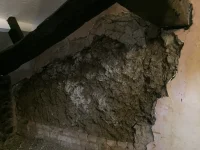dh7626
New Member
Hi all
I hope you can advice
This wall was batoned and plastered but the plaster was in need of replacing. Once removed the old plaster was revealed and was mostly falling off so I removed the loose and am left with basically a mud wall must be about a foot deep and separates from my neighbours so can’t be removed.
I need to line plaster it.
I want the brick at the bottom left exposed but the plaster will have to be deep in parts.
Question is:
Thick lime mortar or build it out with another material first?
Thanks in advance





I hope you can advice
This wall was batoned and plastered but the plaster was in need of replacing. Once removed the old plaster was revealed and was mostly falling off so I removed the loose and am left with basically a mud wall must be about a foot deep and separates from my neighbours so can’t be removed.
I need to line plaster it.
I want the brick at the bottom left exposed but the plaster will have to be deep in parts.
Question is:
Thick lime mortar or build it out with another material first?
Thanks in advance



